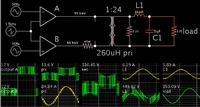sam781
Full Member level 4
I'm trying to make a full bridge converter having the following parameters -
Input nominal voltage = 12v
PWM frequency=80kHz
Transformer turns ratio =34
Expected output dc voltage = 12*34*0.8=326v [duty cycle 80%]
Now, to get the expected dc voltage, I want to calculate required inductance and capacitance to make LC filter. I've read some post but still not clear about the calculation.
Ripple voltage and current can be taken as 1% and 10% respectively. What equations should I consider for L and C?
Input nominal voltage = 12v
PWM frequency=80kHz
Transformer turns ratio =34
Expected output dc voltage = 12*34*0.8=326v [duty cycle 80%]
Now, to get the expected dc voltage, I want to calculate required inductance and capacitance to make LC filter. I've read some post but still not clear about the calculation.
Ripple voltage and current can be taken as 1% and 10% respectively. What equations should I consider for L and C?



